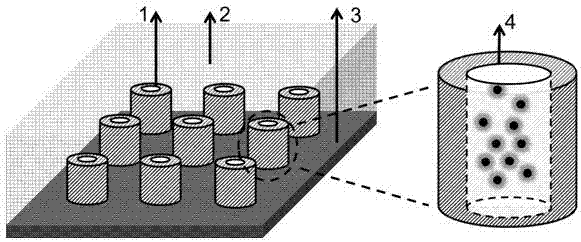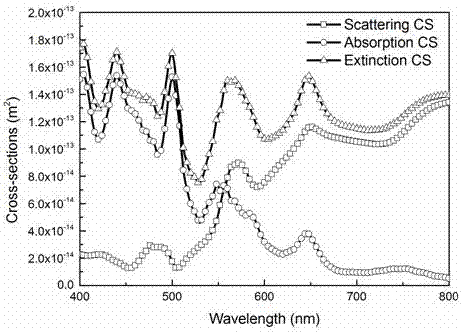Ring cavity nanometer antenna for controlling radiation of plurality of random incoherent single-photon emitters
A nano-antenna and transmitter technology, which is applied in the direction of antenna, radiating element structure, antenna grounding switch structure connection, etc., can solve the problems of difficult photodetector detection, difficult preparation, and non-directional radiation, etc., to improve radiation strength, increase collection efficiency, and simplify process requirements
- Summary
- Abstract
- Description
- Claims
- Application Information
AI Technical Summary
Problems solved by technology
Method used
Image
Examples
Embodiment 1
[0030] Ring cavity nanoantenna structure based on high refractive index dielectric Si, the specific structure is as follows figure 1 As shown, among them: 1 is Si ring-cavity nanoantenna; 2 is PMMA matrix; 3 is SiO 2 Substrate whose refractive index is consistent with PMMA; 4 is InP quantum dot with intrinsic quantum efficiency of 1. And a number of randomly arranged and irrelevant InP quantum dots filled the entire Si cavity.
[0031] like figure 2 As shown, multiple resonant modes can be seen appearing in the extinction spectrum. This Si ring-cavity nano-antenna 1 and the environment matrix 2 PMMA have a large refractive index difference, which can generate multiple strong resonance modes, which can be coupled with the excitation band and emission band used for InP quantum dots 4 to enhance its radiation intensity.
[0032] In this embodiment, the Si ring-cavity nano-antenna 1 is designed for InP quantum dots with an excitation wavelength of 500 nm and an emission wavel...
Embodiment 2
[0035] Ring cavity nanoantenna structure based on high refractive index dielectric Si, the structure is as follows figure 1 As shown, among them: 1 is Si ring-cavity nanoantenna; 2 is PMMA matrix; 3 is SiO 2 Substrate; 4 is InP quantum dots with an intrinsic quantum efficiency of 1, an excitation wavelength of 500nm, and an emission wavelength of 655nm; a layer of InP quantum dots with a thickness of 20nm containing multiple randomly arranged incoherent InP quantum dots is placed at the bottom of the Si cavity.
[0036] Wherein, the spectrum elimination, resonant mode, and electromagnetic field enhancement of Si ring-cavity nano-antenna 1 are consistent with Embodiment 1, such as figure 2 shown.
[0037] like Figure 4 Shown is the calculated overall far-field pattern of all incoherent InP quantum dots with a thickness of 20 nm at the bottom of the cavity of the Si ring cavity nanoantenna 1 and the radiation enhancement factor relative to the case without nanoantennas. It ca...
PUM
 Login to View More
Login to View More Abstract
Description
Claims
Application Information
 Login to View More
Login to View More - R&D Engineer
- R&D Manager
- IP Professional
- Industry Leading Data Capabilities
- Powerful AI technology
- Patent DNA Extraction
Browse by: Latest US Patents, China's latest patents, Technical Efficacy Thesaurus, Application Domain, Technology Topic, Popular Technical Reports.
© 2024 PatSnap. All rights reserved.Legal|Privacy policy|Modern Slavery Act Transparency Statement|Sitemap|About US| Contact US: help@patsnap.com










